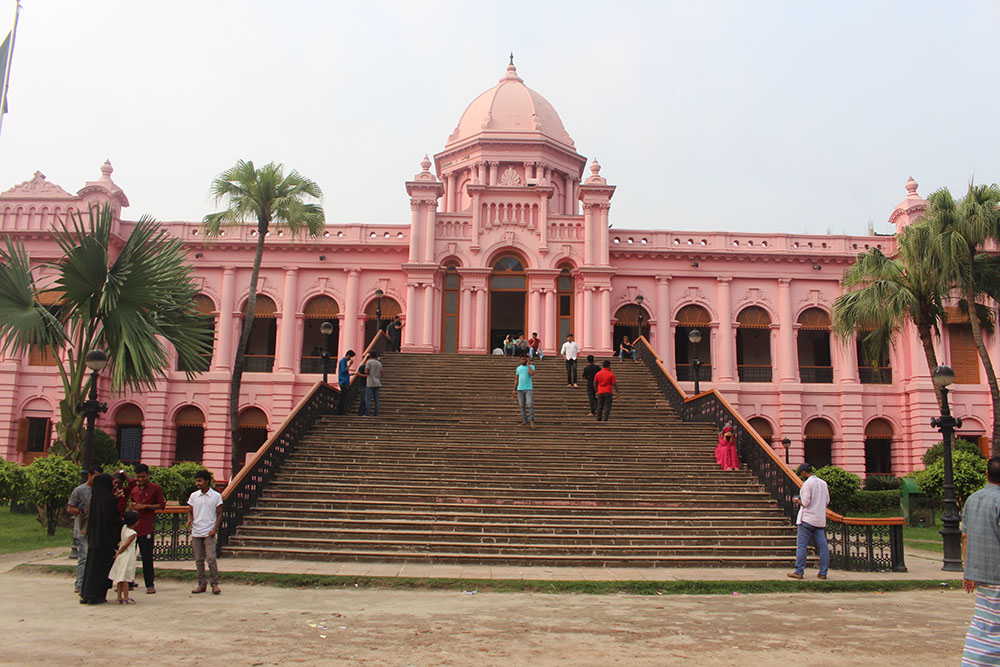
Dhaka describes Bangladesh as a whole. A vibrant and lively city with so much to offer to any travelers heading to Bangladesh. Bangladesh is a megacity and also one of the oldest in the whole of Asia. It has been the core of commercial and cultural exchange throughout the Mughal Empire and the years following it. Additionally, this city has two sides. The modern one takes care of all your travel amenities a more medieval form of itself treating you with historic and cultural delights. In other words, Dhaka is for everyone. Within a rickshaw ride, you will have an instant connection to the streets and locals here. These amongst many are the reasons behind many travelers here pick Dhaka as the must-explore place in Bangladesh. Here are some of the many beautiful places to visit in Bangladesh.
National Parliament House:
In the heart of Dhaka’s bustling commercial city is one of the largest legislative cities in the world the Jatiyo Sangsad Bhaban. Designed by the legendary architect Louis Khan, the building and periphery covers over 200 acres of land. To put it all the lawns, lakes and the whole structure represent the Bangladeshi culture perfectly. Apart from the main legislative segment, other parts of the National Parliament House are open to visitors throughout the year. Similarly, across the road, there is a Crescent Lake. It is accompanied by a beautiful garden named Chandrima Uddan for your visit as well. The unique and contemporary design of Jatiyo Sangsad Bhaban is one not to miss in Dhaka.
Lalbagh Fort:
The Lalbagh Fort is one of the most iconic and historic forts in Bangladesh. The then Prince Mohammed Azam initiated the construction of this picturesque palace, a 17th-century masterpiece. However, it was never fully completed, as it lost popularity when the capital was moved from Dhaka to Murshidabad. First called by the name of Aurangabad, it was later renamed as the Lalbagh fort marking the end of a royal Mughal era.
The fort can be separated into three parts: the main mosque, the tomb of Bibi Pari, and Diwan-i-Aam. The two gateways to the Lalbagh fort are partly damaged with some paintings in the palace showing them in their original condition. Recent archeological research has found the continuity of the remaining part of the fort and even some new parts of the Lalbagh Fort. Lalbagh Fort is open for visitors to explore and get closer to the Mughal history in Dhaka.
Sonargaon:
Sonargaon mosques are also locally popular as the location for the ‘city of Panam’ or ‘Panamnagar’ an ancient historical city within a short drive from Dhaka. It is one of the most visited tourist areas in Dhaka province. Historically it was a port and trading center and at some time was also the capital of the old region of Bengal. As one can expect of the Capital, Sonargaon boasts an exquisite convergence of monuments, mosques, and cultural components. The ancient Goladi Mosque, the Tomb of the 3rd Sultan of Bangladesh, Bara Sadar Bari, and the lost city of Panam are some of the must-be attractions in Sonargaon. Panam City was a well-managed city, now full of ancient buildings and monuments. Apart from the ancient constituents, you can also explore the Bangladeshi folk Arts and Crafts Foundation at the heart of Sonargaon.
Ahsan Manzil:
On the banks of Buriganga River, Ahsan Manzil or the Pink Palace was the residential place as well as the seat of the Nawab of Dhaka. A tornado partially destroyed the original palace just 16 years after construction. The richest individual in Bangladesh then owned and extensively decorated the renovated palace. Additional changes followed the Bangladeshi Nawabs’ fallout, and in the 1980s, the palace was transformed into a cultural and heritage destination for visitors in Dhaka. The walls are full of historic photographs, visits from different royal and high-end guests, paintings, riverports, and artifacts in Ahsan Manzil.
Sadarghat:
Sadharghat is one of the liveliest, buzzing, and vibrant riverports in Bangladesh. In front of the Ashan Manjil, was a significant boat, launch, and even small ship departure station over the Buriganga River. Although the number has gone down drastically over the years, over a hundred boats and launches heading toward hectares in the southern districts of Bangladesh today. It is also the main means of traveling for many locals here. Visitors might also head to the markets here and try some local products in Sadarghat. Photography lovers from all around the world visit here to capture the action around here in their lens.
National Botanical Garden:
The National Botanical Garden in Mirpur, Dhaka is one of the few places you can visit in the capital for exploring the rich flora of Asia. Established in 1961, this 84-hectare garden divides into 57 sectors, comprising ponds and small tree patches. In the garden, there is also a cactus house, half a dozen lakes, two nurseries, a tissue culture research center, and an extensive orchid house. the National Botanical Garden is a must-visit place in Dhaka for nature lovers and biologists alike.
Dhaka is a never-ending maze of delights holding the culture and lifestyle of locals in Bangladesh. Alongside all these beautiful places there are some more which you would like to add to your itinerary during your visit here such as Dhakeshwari Temple. It is about 1,200 years old Hindu temple which is also the center of Hinduism in Dhaka.
Shahid Minar:
A martyr monument to commemorate those losing their lives during the Bengali language movement of 1952 in Bangladesh (then East Pakistan).
Husaini Dalan:
A 17th-century monument that is the venue of Muslim gatherings for Majlis in the month of Muharram.
Liberation War Museum:
A museum in Dhaka commemorating the Bangladesh Liberation War which led to the independence of Bangladesh from Pakistan (1971).
Star Mosque:
One of the most beautiful Mosques in Dhaka built in Mughal style and has four corner towers.
Armenian Church:
Made in the late 17th century after the Armenian colony living here.







